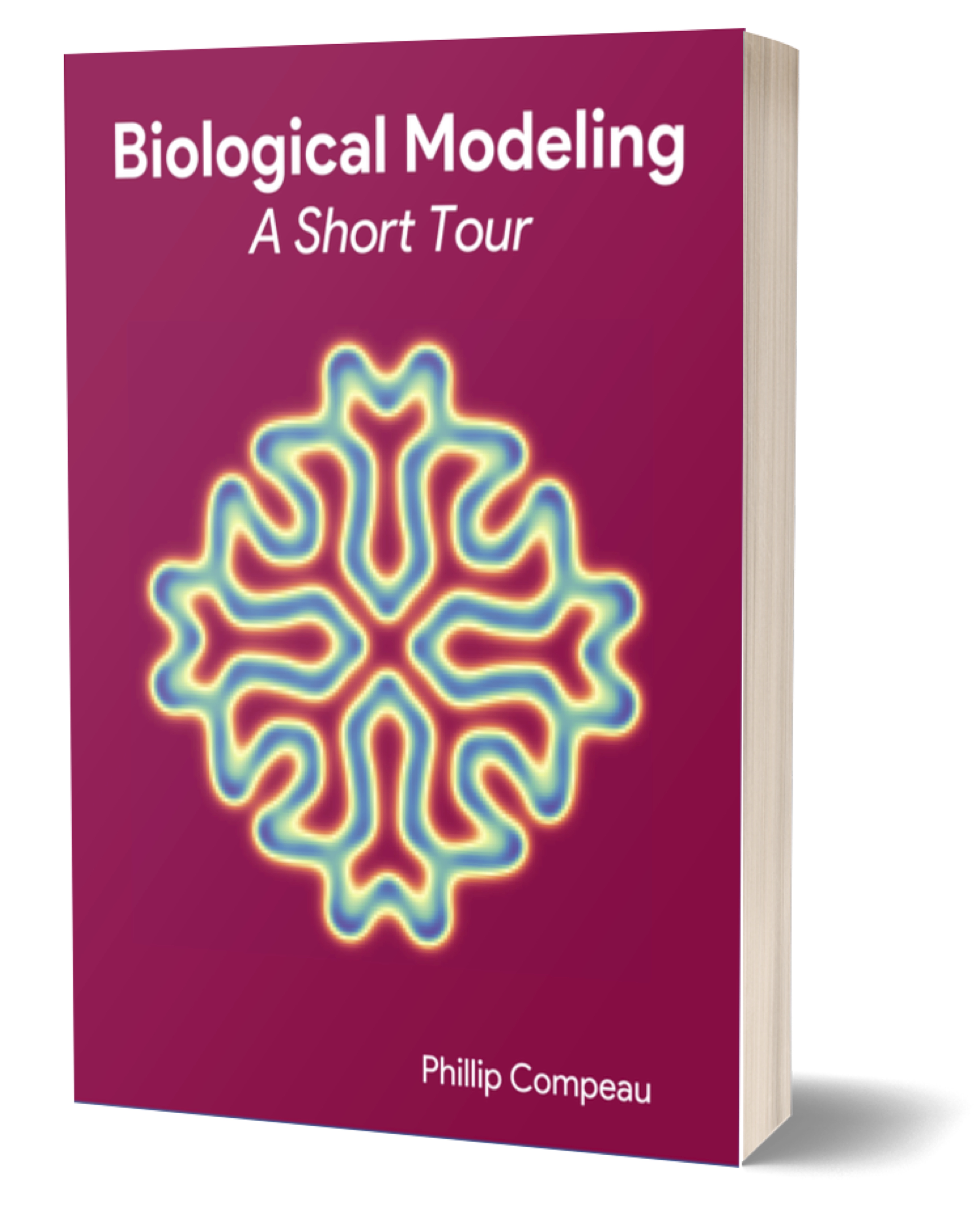The following tutorial will use a Jupyter Notebook to implement the Gray-Scott model. It requires a familiarity with Python, and installation instructions can be found in our coarse-grained diffusion tutorial. You may also download the completed tutorial file here.
Assuming you have Jupyter notebook, create a new file called gray-scott.ipynb (you may instead want to duplicate and modify your diffusion_automaton.ipynb file from the diffusion tutorial).
Note: You should make sure to save this notebook on the same level as another folder named /dif_images. ImageIO will not always create this folder automatically, so you may need to create it manually.
At the top of the notebook, we need the following imports and declarations along with a specification of the simulate function that will drive our Gray-Scott simulation.
import matplotlib.pyplot as plt
import numpy as np
import time
from scipy import signal
import imageio
%matplotlib inline
'''
Simulate function
Description: Simulate the Gray-Scott model for numIter iterations.
Inputs:
- numIter: number of iterations
- A: prey matrix
- B: predator matrix
- f: feed rate
- k: kill rate
- dt: time constant
- dA: prey diffusion constant
- dB: predator diffusion constant
- lapl: 3 x 3 Laplacian matrix to calculate diffusion
Outputs:
- A_matrices: Prey matrices over the course of the simulation
- B_matrices: Predator matrices over the course of the simulation
'''
The Simulate function will take in the same parameters as the Diffuse function from the diffusion tutorial, but it will also take parameters f and k corresponding to the Gray-Scott feed and kill parameters, respectively. The simulation is in fact very similar to the diffusion notebook except for a very slight change that we make by adding the feed, kill, and predator-prey reactions when we update the matrices A and B containing the concentrations of the two particles over all the cells in the grid.
images = []
def Simulate(numIter, A, B, f, k, dt, dA, dB, lapl, plot_iter):
print("Running Simulation")
start = time.time()
# Run the simulation
for iter in range(numIter):
A_new = A + (dA * signal.convolve2d(A, lapl, mode='same', boundary='fill', fillvalue=0) - (A * B * B) + (f * (1-A))) * dt
B_new = B + (dB * signal.convolve2d(B, lapl, mode='same', boundary='fill', fillvalue=0) + (A * B * B) - (k * B)) * dt
A = np.copy(A_new)
B = np.copy(B_new)
if (iter % plot_iter is 0):
plt.clf()
plt.imshow((B / (A+B)),cmap='Spectral')
plt.axis('off')
now = time.time()
# print("Seconds since epoch =", now-start)
# plt.show()
filename = 'gs_images/gs_'+str(iter)+'.png'
plt.savefig(filename)
images.append(imageio.imread(filename))
return A, B
The following parameters will establish the grid size, the number of iterations we will range through, and where the predators and prey will start.
# _*_*_*_*_*_*_*_*_* GRID PROPERTIES *_*_*_*_*_*_*_*_*_*
grid_size = 101 # Needs to be odd
numIter = 5000;
seed_size = 11 # Needs to be an odd number
A = np.ones((grid_size,grid_size))
B = np.zeros((grid_size,grid_size))
# Seed the predators
B[int(grid_size/2)-int(seed_size/2):int(grid_size/2)+int(seed_size/2)+1, \
int(grid_size/2)-int(seed_size/2):int(grid_size/2)+int(seed_size/2)+1] = \
np.ones((seed_size,seed_size))
The remaining parameters establish feed rate, kill rate, time interval, diffusion rates, the Laplacian we will use, and how often to draw a board to an image when rendering the animation.
# _*_*_*_*_*_*_*_*_* SIMULATION VARIABLES *_*_*_*_*_*_*_*_*_*
f = 0.055
k = 0.117
dt = 1.0
dA = 1.0
dB = 0.5
lapl = np.array([[0.05, 0.2, 0.05],[0.2, -1.0, 0.2],[0.05, 0.2, 0.05]])
plot_iter = 50
After adding the code below to the bottom of the notebook, we are now ready to save our file and run the program to generate the animations.
simulate(numIter, A, B, f, k, dt, dA, dB, lapl, plot_iter)
imageio.mimsave('gs_images/gs_movie.gif', images)
When you run your simulation, you should see an image analogous to the one in the diffusion simulation, but with much more complex behavior since we have added reactions to our model. Try changing the feed and kill rate very slightly (e.g., by 0.01). How does this affect the end result of your simulation? What if you keep making changes to these parameters? do slight changes in the should get images similar to the ones below.
In the main text, we will discuss how much as we saw with the particle-based reaction-diffusion model, slight changes to the critical parameters in our model can produce vast differences in the beautiful patterns that emerge.
